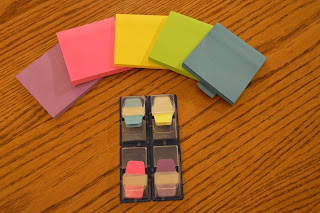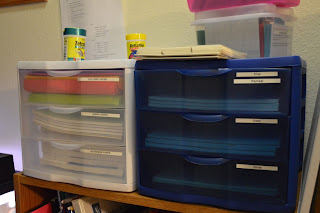The Calvin Institute for Higher Learning opens the 2013-2014 school year in 11 days - which means this Mommy-teacher is in overdrive organizing and lesson planning. With 8 years of home education under my belt, and about 16 more to go, I have learned that starting the year over-organized helps keep us running smoothly all year. While I still have a few finishing touches to go, mostly storing unneeded books from last school year, everything should be in its place and ready for, um, eager students.My primary goals have been: ease of use for everyone, allowing each child to be as self-sufficient as possible and keeping costs to a minimum. I also took appearance into greater consideration this year. After 8 years of my dining room looking like a kindergarten classroom, I was ready to try to make all the school stuff blend in more.
One of the best things I did when my oldest girls were little was color code everyone. Every child has an assigned color, and all their things are in that color - towels, toothbrushes, bedsheets, school supplies. Last fall I discovered Post-It Notes can be bought individually for about $1 at Walmart and Target! I now keep a supply in every child's color. They are slighly more expensive bought this way, but they have paid me back in time and stress relief many times over.
This year I designated a shelf for myself. All my teacher's manuals, reference books, planning aids, and supplies are there. This year I needed to rebind all my math manuals - year after year of use had them in shambles. They are all in 3-ring binders, with Post-it tabs separating the different sections (lessons, worksheet answers, test answers etc..) Each manual contains a Post-it corresponding to the color of the child using that book, marking what lesson they are on. 5 kids schooling full time this year, I can't remember who is using what most of the time! This has been very helpful when I have multiple children using the same book, but are working at different points. I just need to grab the manual and I am ready to go - no looking up lesson plans that usually don't get done! The top shelf is all the manuals currently being used; middle shelf planning and reference; bottom shelf is art, music and PE activities for rainy days. The cabinet next to my shelf has a shelf designated for books and supplies that will be used this year, but not right away.
To help the children keep track of what they have done and what needs to be done I put together this board. Each tile (color coded for each child) has a picture of a subject. The tiles of the subjects that need to be worked on are moved to the "To Do" side each morning, and get moved back when its been completed. This was new this past school year and a HUGE hit with the kids. I also purchased a simple kitchen timer for each child to help them keep track of how long they have worked on a subject - early time management training!
Each child has his own shelf, or two, containing their books and a 3-ring binder for each subject - color coded of course! All the workbooks have been pulled apart and placed into the binders. Not only do they sit better on the shelves, but it is easier for the children to work on them. If we need to take school out they can bring only the pages needed to be completed. It also allows more freedom in working in different areas of the house, or outside. The magazine holders contain workbooks that could not be taken apart, soft cover texts, folders for Sunday School and Sermon Notes and anything else that doesn't stand well on its own. These are inexpensive cardboard ones from Ikea.
Each binder and book has a color coded Post It to be used as a bookmark.
Paper storage. Those children who still need handwriting practice have a drawer with their sized handwriting paper. There is also one for notebook paper, colored paper and graph paper. My label maker has been invaluable when organizing supplies! With everything clearly labeled there is no excuse for things not being put away or not being able to find something.
My big challenge this year was science supplies. With one studying high school Biology and 4 elementary physics, there are a tremendous amount of supplies - some of which are toxic or dangerous to little ones who love to play with anything they can get their hands on. These drawers from Walmart, with organizing bins from Family Dollar, will hopefully make everything easier to find and put away. Everything is labeled on the outside of the drawer and inside on bins. Supplies that anyone can play with are on the bottom; "not intended for small children" items on the top. These have given me a great way to store the recyclable supplies I like to have on hand - cardboard roles, empty soda bottles, pill bottles etc.. In the back corner of my kitchen pantry is a second set of drawers with the really dangerous or fragile stuff - dissection kits and specimen, chemicals, microscope and slide-making supplies.
The Community Supply Shelf. Everything that everyone needs easy access to! The drawers on the top shelf (from Ikea) hold office supplies - pencils, crayons, markers, scissors, glue, rulers etc... This summer I went through and got rid of all the cheaply made items and restocked with higher quality materials. I found that those $.25 crayons may be cheap, but they are so hard to use that they would deter the kids from crafts and creativity. They also break easily and need to be replaced more often. These are now stocked with Crayola crayons and markers, 100% wooden pencils and rulers, metal protractors... It is usually a lot less expensive in the long run to buy higher quality materials.
The second shelf holds reference books from a children's dictionary to Roget's Thesaurus, a rhyming dictionary, a variety of atlases, a study Bible and concordance.
The bottom shelf is coloring books to keep little ones entertained and science field guides and encyclopedias.
 Another new addition this year is our Memorization Wall. We never get to our memory work, because unless it is in front of me, I don't think about it. I put white posterboard into frames from GoodWill, hung them up and can now write our memory work in wet erase markers. I would like one more for Science, but right now I have room for Poetry, History, Catechism and Scripture
Another new addition this year is our Memorization Wall. We never get to our memory work, because unless it is in front of me, I don't think about it. I put white posterboard into frames from GoodWill, hung them up and can now write our memory work in wet erase markers. I would like one more for Science, but right now I have room for Poetry, History, Catechism and ScriptureIn the garage, is a tub for each subject, storing everything that isn't being used this school year. Unfortunately, even after getting rid of 5 boxes of books this spring, we are outgrowing many of these tubs. Yes, my tubs are color coded. Grey ones are for school, blue is outdoor clothing, green is Christmas supplies, and pink is Easter supplies.
 |
| Add caption |
Finally - record keeping! Still very much a work in progress. We have never lived in a state that required it, so it has never been a priority for me. I have a heavy duty 3 inch color coded binder for each child. At the end of the school year they choose 3-4 of their favorite examples of work from each subject which are filed behind a divider marked with the school year. This year I began one for high school level work for our oldest. Since she is completing high school courses before reaching the typical high school age, I have divided that one by subject. Behind each subject divider are tests, lab reports, and essays in a plastic sleeve labeled with the course name and date completed. I purchased Home School Tracker Plus to help me with keeping grades, amount of time worked, course descriptions, curriculum and lesson plans that are needed for college admissions. The binder provides paper-proof of work done just in case it is required by an admissions office or scholarship board. I rarely have time for daily lesson plans, and have purposely chosen material where daily plans are already written, so this year I put together a spread sheet with each course across the top (color coded by child) and lesson numbers going down. Now I can just date when each lesson has been completed and quickly see where each child is, pacing and what needs to be done.











Wow. Thank you for taking the time to show/explain all of this! I have taken several ideas from here for this year! (I am severely organizationally challenged) So inspired!
ReplyDelete